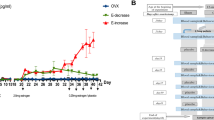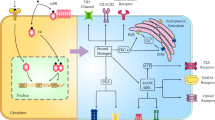Abstract
The pivotal role of estrogens in the pain sensitivity has been investigated in many ways. Traditionally, it is ascribed to the slow genomic changes mediated by classical nuclear estrogen receptors (ER), ERα and ERβ, depending on peripheral estrogens. Recently, it has become clear that estrogens can also signal through membrane ERs (mERs), such as G-protein-coupled ER1 (GPER1), mediating the non-genomic effects. However, the spinal specific role played by ERs and the underlying cellular mechanisms remain elusive. The present study investigated the rapid estrogenic regulation of nociception at the spinal level. Spinal administration of 17β-estradiol (E2), the most potent natural estrogen, acutely produced a remarkable mechanical allodynia and thermal hyperalgesia without significant differences among male, female and ovariectomized (Ovx) rats. E2-induced the pro-nociceptive effects were partially abrogated by ICI 182,780 (ERs antagonist), and mimicked by E2-BSA (a mER agonist). Inhibition of local E2 synthesis by 1,4,6-Androstatrien-3,17-dione (ATD, a potent irreversible aromatase inhibitor), or blockade of ERs by ICI 182,780 produced an inhibitory effect on the late phase of formalin nociceptive responses. Notably, lumbar puncture injection of G15 (a selective GPER1 antagonist) resulted in similar but more efficient inhibition of formalin nociceptive responses as compared with ICI 182,780. At the cellular level, the amplitude and decay time of spontaneous inhibitory postsynaptic currents were attenuated by short E2 or E2-BSA treatment in spinal slices. These results indicate that estrogen acutely facilitates nociceptive transmission in the spinal cord via activation of membrane-bound estrogen receptors.






Similar content being viewed by others
References
Evrard HC (2006) Estrogen synthesis in the spinal dorsal horn: a new central mechanism for the hormonal regulation of pain. Am J Physiol Regul Integr Comp Physiol 291:R291–R299
Ji Y, Tang B, Traub RJ (2011) Spinal estrogen receptor alpha mediates estradiol-induced pronociception in a visceral pain model in the rat. Pain 152:1182–1191
Sanoja R, Cervero F (2005) Estrogen-dependent abdominal hyperalgesia induced by ovariectomy in adult mice: a model of functional abdominal pain. Pain 118:243–253
Bradshaw H, Miller J, Ling Q, Malsnee K, Ruda MA (2000) Sex differences and phases of the estrous cycle alter the response of spinal cord dynorphin neurons to peripheral inflammation and hyperalgesia. Pain 85:93–99
Fehrenbacher JC, Loverme J, Clarke W, Hargreaves KM, Piomelli D et al (2009) Rapid pain modulation with nuclear receptor ligands. Brain Res Rev 60:114–124
Mannino CA, South SM, Quinones-Jenab V, Inturrisi CE (2007) Estradiol replacement in ovariectomized rats is antihyperalgesic in the formalin test. J Pain 8:334–342
Cao DY, Ji Y, Tang B, Traub RJ (2012) Estrogen receptor beta activation is antinociceptive in a model of visceral pain in the rat. J Pain 13:685–694
Evrard HC, Balthazart J (2004) Rapid regulation of pain by estrogens synthesized in spinal dorsal horn neurons. J Neurosci 24:7225–7229
Evrard H, Baillien M, Foidart A, Absil P, Harada N, Balthazart J (2000) Localization and controls of aromatase in the quail spinal cord. J Comp Neurol 423:552–564
Liu NJ, Chakrabarti S, Schnell S, Wessendorf M, Gintzler AR (2011) Spinal synthesis of estrogen and concomitant signaling by membrane estrogen receptors regulate spinal κ- and μ-opioid receptor heterodimerization and female-specific spinal morphine antinociception. J Neurosci 31:11836–11845
Papka RE, Storey-Workley M, Shughrue PJ, Merchenthaler I, Collins JJ, Usip S, Saunders PT, Shupnik M (2001) Estrogen receptor-alpha and beta-immunoreactivity and mRNA in neurons of sensory and autonomic ganglia and spinal cord. Cell Tissue Res 304:193–214
VanderHorst VG, Gustafsson JA, Ulfhake B (2005) Estrogen receptor-alpha and -beta immunoreactive neurons in the brainstem and spinal cord of male and female mice: relationships to monoaminergic, cholinergic, and spinal projection systems. J Comp Neurol 488:152–179
Dun SL, Brailoiu GC, Gao X, Brailoiu E, Arterburn JB, Prossnitz ER, Oprea TI, Dun NJ (2009) Expression of estrogen receptor GPR30 in the rat spinal cord and in autonomic and sensory ganglia. J Neurosci Res 87:1610–1619
Filardo EJ, Quinn JA, Frackelton AR Jr, Bland KI (2002) Estrogen action via the G protein-coupled receptor, GPR30: stimulation of adenylyl cyclase and cAMP-mediated attenuation of the epidermal growth factor receptor-to-MAPK signaling axis. Mol Endocrinol 16:70–84
Feng Y, Gregor P (1997) Cloning of a novel member of the G protein-coupled receptor family related to peptide receptors. Biochem Biophys Res Commun 231:651–654
Maggiolini M, Picard D (2010) The unfolding stories of GPR30, a new membrane-bound estrogen receptor. J Endocrinol 204:105–114
Revankar CM, Cimino DF, Sklar LA, Arterburn JB, Prossnitz ER (2005) A transmembrane intracellular estrogen receptor mediates rapid cell signaling. Science 307:1625–1630
Kuhn J, Dina OA, Goswami C, Suckow V, Levine JD et al (2008) GPR30 estrogen receptor agonists induce mechanical hyperalgesia in the rat. Eur J Neurosci 27:1700–1709
Levin ER (2009) Plasma membrane estrogen receptors. Trends Endocrinol Metab 20:477–482
Mermelstein PG (2009) Membrane-localised oestrogen receptor alpha and beta influence neuronal activity through activation of metabotropic glutamate receptors. J Neuroendocrinol 21:257–262
Micevych P, Dominguez R (2009) Membrane estradiol signaling in the brain. Front Neuroendocrinol 30:315–327
Vasudevan N, Pfaff DW (2008) Non-genomic actions of estrogens and their interaction with genomic actions in the brain. Front Neuroendocrinol 29:238–257
Jiang P, Kong Y, Zhang XB, Wang W, Liu CF, Xu TL (2009) Glycine receptor in rat hippocampal and spinal cord neurons as a molecular target for rapid actions of 17-beta-estradiol. Mol Pain 5:2
Xu JJ, Walla BC, Diaz MF, Fuller GN, Gutstein HB (2006) Intermittent lumbar puncture in rats: a novel method for the experimental study of opioid tolerance. Anesth Analg 103:714–720
Cheng LZ, Lü N, Zhang YQ, Zhao ZQ (2010) Ryanodine receptors contribute to the induction of nociceptive input-evoked long-term potentiation in the rat spinal cord slice. Mol Pain 6:1
Bondar G, Kuo J, Hamid N, Micevych P (2009) Estradiol-induced estrogen receptor-alpha trafficking. J Neurosci 29:15323–15330
Kow LM, Pfaff DW (2004) The membrane actions of estrogens can potentiate their lordosis behavior-facilitating genomic actions. Proc Natl Acad Sci USA 101:12354–12357
Balthazart J, Ball GF (2006) Is brain estradiol a hormone or a neurotransmitter? Trends Neurosci 29:241–249
Hojo Y, Murakami G, Mukai H, Higo S, Hatanaka Y, Ogiue-Ikeda M, Ishii H, Kimoto T, Kawato S (2008) Estrogen synthesis in the brain—role in synaptic plasticity and memory. Mol Cell Endocrinol 290:31–43
Collins P, Webb C (1999) Estrogen hits the surface. Nat Med 5:1130–1131
Edwards DP (2005) Regulation of signal transduction pathways by estrogen and progesterone. Annu Rev Physiol 67:335–376
Levin ER (2002) Cellular functions of plasma membrane estrogen receptors. Steroids 67:471–475
Abraham IM, Todman MG, Korach KS, Herbison AE (2004) Critical in vivo roles for classical estrogen receptors in rapid estrogen actions on intracellular signaling in mouse brain. Endocrinology 145:3055–3061
Nadal A, Ropero AB, Fuentes E, Soria B (2001) The plasma membrane estrogen receptor: nuclear or unclear? Trends Pharmacol Sci 22:597–599
Qiu J, Bosch MA, Tobias SC, Grandy DK, Scanlan TS, Ronnekleiv OK, Kelly MJ (2003) Rapid signaling of estrogen in hypothalamic neurons involves a novel G-protein-coupled estrogen receptor that activates protein kinase C. J Neurosci 23:9529–9540
Fillingim RB, King CD, Ribeiro-Dasilva MC, Williams BR, Riley JL III (2009) Sex, gender, and pain: a review of recent clinical and experimental findings. J Pain 10:447–485
Berkley KJ (1997) Sex differences in pain. Behav Brain Sci 20:371–380
Fischer L, Torres-Chávez KE, Clemente-Napimoga JT, Jorge D, Arsati F, de Arruda Veiga MC, Tambeli CH (2008) The influence of sex and ovarian hormones on temporomandibular joint nociception in rats. J Pain 9:630–638
Unruh AM (1996) Gender variations in clinical pain experience. Pain 65:123–167
Craft RM, Mogil JS, Aloisi AM (2004) Sex differences in pain and analgesia: the role of gonadal hormones. Eur J Pain 8:397–411
Cornil CA, Ball GF, Balthazart J (2006) Functional significance of the rapid regulation of brain estrogen action: where do the estrogens come from? Brain Res 1126:2–26
Kondo D, Yabe R, Kurihara T, Saegusa H, Zong S, Tanabe T (2006) Progesterone receptor antagonist is effective in relieving neuropathic pain. Eur J Pharmacol 541:44–48
Greenspan JD, Craft RM, LeResche L, Arendt-Nielsen L, Berkley KJ, Fillingim RB, Gold MS, Holdcroft A, Lautenbacher S, Mayer EA et al (2007) Studying sex and gender differences in pain and analgesia: a consensus report. Pain 132:S26–S45
Ledoux VA, Woolley CS (2005) Evidence that disinhibition is associated with a decrease in number of vesicles available for release at inhibitory synapses. J Neurosci 25:971–976
Li W, Jin X, Covey DF, Steinbach JH (2007) Neuroactive steroids and human recombinantrho1 GABAC receptors. J Pharmacol Exp Ther 323:236–247
Rudick CN, Woolley CS (2001) Estrogen regulates functional inhibition of hippocampal CA1 pyramidal cells in the adult female rat. J Neurosci 21:6532–6543
Acknowledgments
This work was supported by National Basic Research Program of China (Grant 2007CB512502) and National Natural Science Fund of China (NSFC, 31121061, 31070973, 30900444 and 30830044).
Author information
Authors and Affiliations
Corresponding authors
Rights and permissions
About this article
Cite this article
Zhang, Y., Lü, N., Zhao, ZQ. et al. Involvement of Estrogen in Rapid Pain Modulation in the Rat Spinal Cord. Neurochem Res 37, 2697–2705 (2012). https://doi.org/10.1007/s11064-012-0859-1
Received:
Revised:
Accepted:
Published:
Issue Date:
DOI: https://doi.org/10.1007/s11064-012-0859-1




